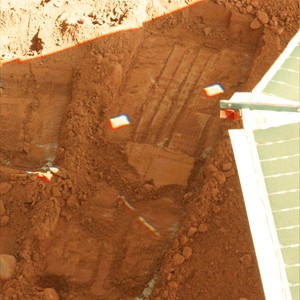As the UA-led Phoenix Mars Lander mission enters its final stages, it is clear that this mission has paved the way for further exploration of the Red Planet.
Carla Bitter, education and public outreach officer for NASA’s Phoenix Mars Lander, said that changes in the Martian climate have begun to limit the capabilities of the Mars Lander and will soon lead to its termination.
“”The problem is, it’s getting really, really cold – it’s starting to get really dark and it is a solar powered spacecraft, so that’s a problem,”” Bitter explained. “”We’re getting the real last bit of science through, the last bit of juice out of all of our experiments and digging.””
One of the most exciting recent discoveries actually had nothing to do with digging, but fell from the Martian sky, she said.
“”It is really the first time a mission on the ground of Mars – or any planet, in fact – has seen snowfall, so that is kind of extraordinary,”” Bitter said. “”Precipitation is falling but it is so dry that it does not actually make it to the ground.””
Due to the decreasing amount of solar power available to the Mars Lander, the next two weeks are crucial in terms of getting as much research done as possible, Bitter said.
“”About October 24 we will start to take the science instruments and the robotic arm offline, putting them sort of in their final resting place, their final configurations,”” she said.
Once these instruments are shut down, Bitter said the lander will begin to function as a sophisticated weather station.
“”We will continue to do atmosphere … temperature (and) wind speed (observations) as well as some imaging for the period of time from maybe the week of October 25 hopefully (until) … midway through November when solar conjunction happens,”” Bitter said.
During solar conjunction, the Sun is directly between the Earth and Mars and will prevent the scientists from communicating with the Mars Lander for a period of anywhere from 10 days to two weeks.
Once scientists are able to reconnect with the lander it is anyone’s guess if it will be able to continue even basic operations, Bitter said.
“”We will certainly try to get it out of the sleeping beauty mode and see if we can work with it a bit more,”” she said.
The Mars Lander is currently in its second extended mission and performing exceptionally well – a tribute to the people who have worked on the project.
“”The (UA) has a long history of being involved in Mars missions so this is really the pinnacle, the high point of this involvement over the last few decades,”” Bitter said.
The overwhelming success of the UA-based Mars Lander has opened the door to further exploration of the Martian atmosphere, Bitter said.
“”Phoenix was the first scout mission, the second scout mission, which was just announced recently, was given to the University of Colorado,”” Bitter said. “”Certainly having one successful scout mission paves the way for the whole scout mission program.””
According to the University of Colorado at Boulder Web site, the MAVEN mission will launch in 2013 with the main purpose of discovering the history of the Martian climate and its potential for supporting life.
“”Phoenix has really created a benchmark of really exploring a part of the planet that we didn’t know that much about. It is a nice starting point to look at the future of the exploration program,”” Bitter said.









